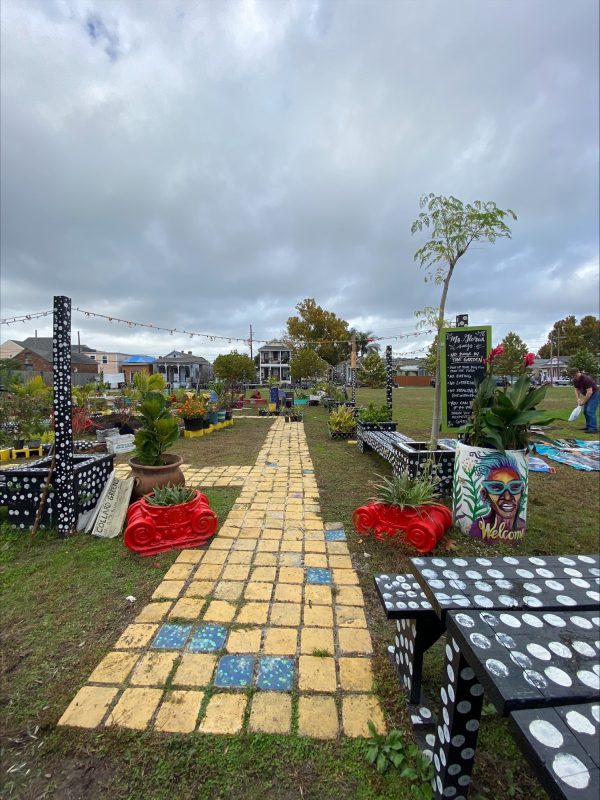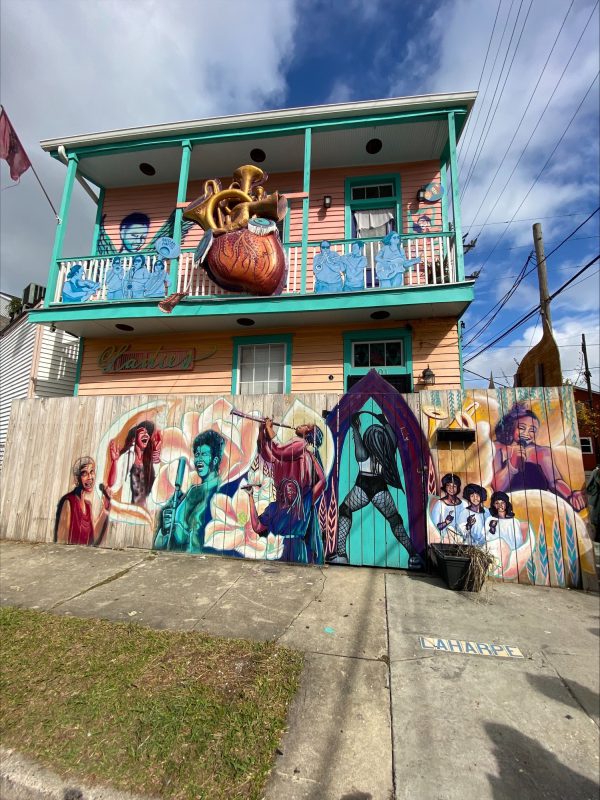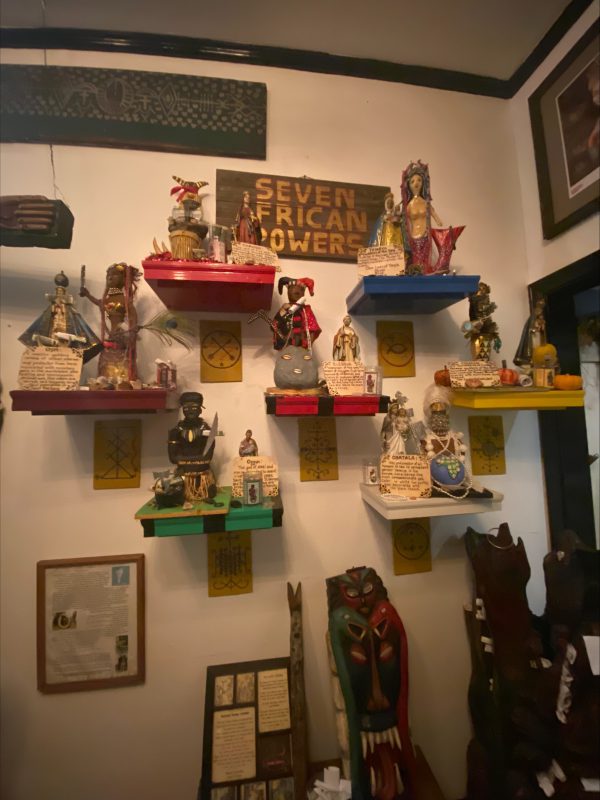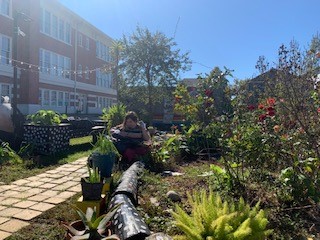A major grant awarded to Kalamazoo College helped 17 students begin experiencing a new dimension of hands-on learning in their humanities coursework through a visit to New Orleans over winter break.
The Andrew W. Mellon Foundation granted $1.297 million in January 2022 to provide new learning opportunities through the College’s Humanities Integrated Locational Learning (HILL) project. HILL builds student coursework rooted in the College’s commitment to experiential learning and social justice to address issues such as racism, economic inequities and homelessness, while examining history, how humans share land, and the dislocations that bring people to a communal space.
Within HILL, there are multiple academic departments represented with clusters of classes that emphasize collaborative learning within the humanities and humanistic social sciences:
- The Beyond Kalamazoo course clusters focus on location or dislocation and emphasize place-based learning through an integrated travel component in New Orleans, St. Louis or San Diego.
- The Within Kalamazoo cluster, which emphasizes a theme relevant to location or dislocation, where faculty directly collaborate on coursework that engages directly with social issues in the Kalamazoo community.
- The digital humanities hub, which publishes, archives and assesses outcomes in relation to course work and partnerships beyond and within Kalamazoo.
New Orleans was the first site on which the Beyond Kalamazoo cluster focused. In fall, courses consisted of Lest We Forget: Memory and Identity in the African Diaspora in New Orleans, taught by Associate Professor of Anthropology Espelencia Baptiste; Public Art and its Publics led by Professor of Art and Art History Christine Hahn; NOLA Divided: Race in the Big Easy, led by Associate Professor of English Shanna Salinas; and The World Through New Orleans, led by Associate Professor of Music Beau Bothwell. Each course operated independently with discipline-specific instruction.
Students interested in doing place-based research in New Orleans applied for the Beyond Kalamazoo cluster, which included six weeks of preparation, instruction on research methodologies in the humanities, the seven-day research trip, and post-trip research and writing. Those students were put into research groups formed by research interest and a distribution of one member from each of the cluster courses, so every group had at least one representative from each of the four cluster courses.
The students’ pre-trip collaboration—based on their knowledge from their respective courses within the departments of English, art history, anthropology-sociology and music—helped them create a collaborative research project that would emphasize location or dislocation, problem solving and social justice in New Orleans.






Their subjects of interest for the projects included the city’s theatre scene, public transportation and historical ties to slavery with each student connecting their social justice interests with each of a variety of community partners. Students were encouraged to use onsite and digital archives at the Historical New Orleans Collection for their projects when applicable.
The community partners included Lower Nine, a nonprofit organization dedicated to the long-term recovery of the Lower Ninth Ward of New Orleans in the wake of Hurricanes Katrina, Ida and Rita, and the levee breaches of 2005; and People for Public Art, an organization of artists that funds, creates and documents works of public art for the City of New Orleans to reflect the stories of the people. Students then worked with these partners during their on-site visit this winter.
Morgan Acord ’23, an English major with a passion for literature, found Salinas’ class to be fascinating because New Orleans has a literature culture all its own, she said. She appreciated that their trip also included cultural opportunities such as participating in a second-line parade, seeing the Oak Alley and Whitney plantations, and observing French and Spanish artifacts at the New Orleans Archive.
Yet for Acord, filling a need for social justice work through a nonprofit was the biggest benefit.
“We helped an 80-year-old woman and her husband who had been sleeping on an air mattress in their kitchen after Hurricane Ida,” Acord said. “They were living in a shotgun-style house and all of her belongings were in what I assumed was the living room. Overall, it showed how catastrophic those New Orleans hurricanes were. You see the footage on TV, but to see it firsthand and see how people live in houses still under repair is eye opening. It felt good on the surface to be able to help, but it was eye opening to know how privileged some of us are.”
Together, Acord and classmates including Josh Kuh ’23, an anthropology-sociology major from Seattle, tore a front wall out of the house that had been destroyed by termites, painted baseboards, and laid down flooring in what was to be the couple’s bedroom. Professor Mills along with Lower Nine representatives assisted in painting the ceiling and the dining room.
“There is a ton of history that none of us knew about before going there, even though we had all taken a class about the city,” Kuh said. “I thought it was valuable to have this structured opportunity that felt like doing more than observing for research. We provided a meaningful service to the organizations that we were working with. I think the biggest takeaways of mine involved seeing firsthand how extensive the hurricane damage was. I saw the disarray in this house and it hadn’t been fixed even though it had been almost 20 years since some of the damage happened.”
Jenna Paterob ’23, a business and psychology double major and art minor, took Professor Hahn’s class in fall because she often feels like she overlooks public art.
“Our experience in New Orleans was educational, eye-opening, fun and immersive,” she said. “It isn’t every day that we get to go into a new area of the country and interact with the community there. I feel like we were able to see bigger issues encapsulated in the city such as tourism, racism, white supremacy and classism. “I feel like when we stay in one place for a long period of time, we may become a little desensitized to the issues that surround us. Therefore, going to a new area, especially as someone who has never been out of the Midwest, was definitely an educational experience for me.”
Paterob had a social justice experience with People for Public Art in New Orleans. During the volunteer day, Paterob worked with her peers to create signs for Ms. Gloria’s Garden. The location offers opportunities for children to garden, cook, sew, make jewelry and music, and take yoga and meditation classes. The garden is managed by a nonprofit, Developing Young Entrepreneurs, which provides youths and young adults with entrepreneurial skills and a safe space for people to feel free to be themselves.
“When I first discovered that we were going to be making signs, I was confused about what that had to do with public art,” she said. “Throughout the day, I discovered that we were seeing different types of public art, allowing us to feel like we were a part of the community. Painting signs for plants in a garden may not be the first thing people think of when they think about public art, but we really did create some fun and beautiful pieces of art that communicate information and improve the garden. I liked that day because I was exposed to a whole new setting and sense of community. I also learned that the organization creates a bunch of impactful pieces, such as the memorial pieces they showed us. They took a tragic event that was minimized and silenced by certain people and allowed the community to come together to grieve. I learned a lot about New Orleans and how the residents interact with their community through learning about the public art there.”
Ally Noel ’24, an anthropology-sociology and English double major, had similar praise for her experience at People for Public Art.
“That day shifted my entire trajectory in terms of my research in New Orleans,” she said. “Going into New Orleans, I had this idea of what I thought I wanted to study but then after Monica (Kelly, representing People for Public Art) was telling the story of the lower mid-city and the inequities that exist there, I realized I wanted to do research on the closure of Charity Hospital after Hurricane Katrina hit. That was the day that everything clicked for me, and I realized, being in that space was important. A student can study a space from afar, but being there helps research in terms of learning and making meaning of the experience.”
Salinas is serving as the curriculum coordinator for integrated travel to New Orleans and a co-principal investigator for the HILL initiative as a whole.
“The primary vision of this initiative is collaboration, be that students sharing their knowledge with other members of their research group based on the cluster class they took, community partners holding space for students to learn about the work they do in New Orleans and the stakes of that work, and research groups working across disciplines in the humanities to develop a digital humanities research project that reflects both their academic knowledge and their experiences in the city,” Salinas said. “We asked students to commit to one eight-hour work day with two of our community partners. Students self-selected according to interest or research investment, frequently with research group members on different work sites. Afterward, students were able to come together and share those experiences with each other and discuss what they learned. It was these moments that enhanced their research and, ultimately, their collaborative projects. HILL’s curricular design relies on students being able to share their experiences, to talk to each other about what they learned, to root in in the type of instruction they received in their cluster classes, and to make those concrete connections back to things like community-building as a crucial element of the humanities.”
As they reflected on their experiences, the students praised the opportunity to go to New Orleans and said they would encourage their peers to seek HILL-focused, place-based learning classes as well.
Baptiste’s class, for example, set the table for students such as Maya Nathwani ’23, an anthropology-sociology and biology double major, to examine history away from campus when she missed a study abroad opportunity because of COVID-19. Lest We Forget: Memory and Identity in the African Diaspora in New Orleans provided Nathwani with a life-changing experience in her college years that she otherwise would’ve missed.
“The class emphasized understanding what history is and how it’s created and produced, along with who has the ability to share and pass on history, impacting how we remember the past,” Nathwani said. “Going to do research in a space where I’d never been was intimidating just because I’d never done it before. But I would encourage other students to try these classes, too, because the professors prepare you to be successful.”
